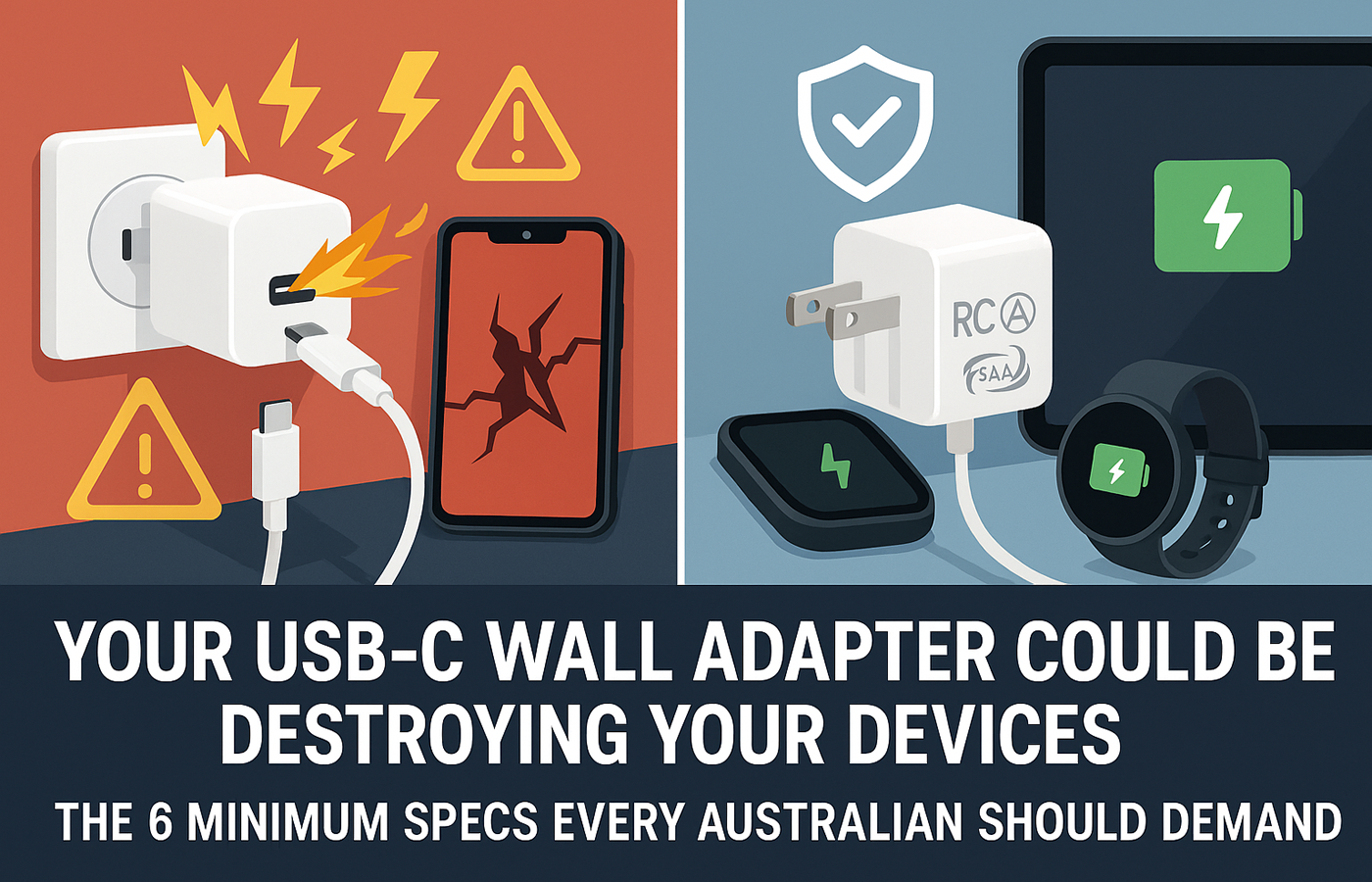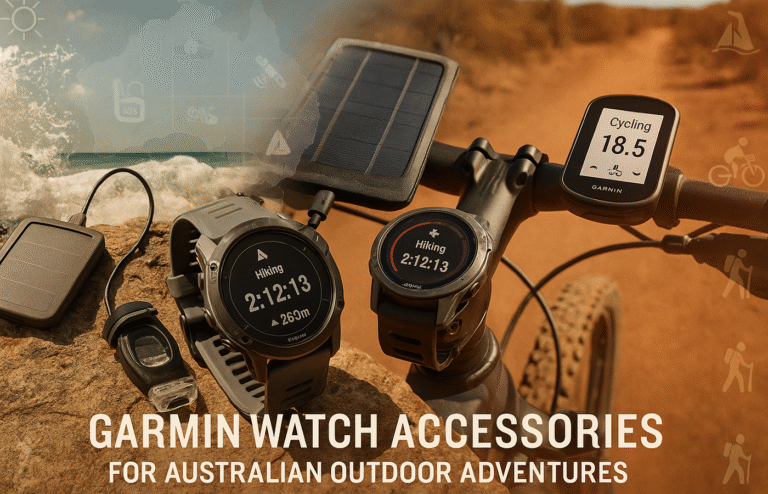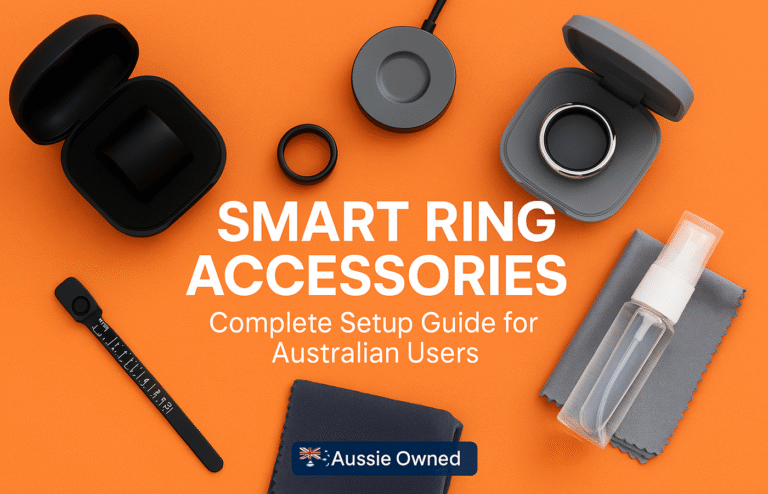USB-C Wall Adapter Minimum Specs: Essential Safety Guide for Australians
Counterfeit USB-C adapters flood the Australian market, potentially damaging expensive devices or creating fire hazards. Six critical specifications separate quality adapters from dangerous knockoffs.
Essential Requirements:
● Genuine Power Delivery 3.0 certification with multiple voltage outputs (5V, 9V, 15V, 20V)
● Australian RCM compliance and SAA certification for electromagnetic compatibility and safety
● GaN technology for 90-95% efficiency versus 80-85% in traditional silicon adapters
● PPS support for Samsung Galaxy and Google Pixel fast charging capabilities
● Multi-port configuration with intelligent power distribution systems
● Comprehensive thermal management and overcurrent protection features
Cost vs Risk:
Quality adapters cost $40-$80 AUD but protect devices worth hundreds whilst ensuring home insurance validity and electrical safety compliance.
Bottom Line: Invest in certified adapters from reputable retailers to avoid device damage, warranty voids, and safety hazards.
Your USB-C Wall Adapter Could Be Destroying Your Devices: The 6 Minimum Specs Every Australian Should Demand
Most Australians are unknowingly using USB-C wall adapters that could be slowly damaging their expensive smartphones, tablets, and wearable devices – or worse, creating serious safety hazards in their homes. With counterfeit adapters flooding the market and legitimate products ranging from $15 to $150, knowing the six critical minimum specifications can mean the difference between safe, efficient charging and a costly disaster.
This comprehensive guide reveals the essential power delivery ratings, safety certifications, and Australian compliance standards that separate quality adapters from dangerous knockoffs, while explaining why that bargain $8 adapter from an unknown brand could end up costing you thousands in device replacements. From understanding GaN technology and PPS (Programmable Power Supply) support to recognising genuine RCM certification marks, we’ll decode the technical jargon and equip you with the insider knowledge needed to choose wall adapters that protect your investment, deliver optimal charging speeds, and meet Australia’s strict electrical safety requirements.
Why Your Current Adapter Might Be a Ticking Time Bomb
Before diving into the essential specifications, it’s crucial to understand the scale of the problem facing Australian consumers. The Australian Competition and Consumer Commission (ACCC) regularly issues warnings about dangerous electrical products, with counterfeit chargers featuring prominently in their safety alerts. These substandard adapters don’t just charge slowly – they can overheat, cause fires, or deliver unstable power that permanently damages your device’s battery and internal circuitry.
Moreover, with the average Australian smartphone costing over $800 and premium smartwatches reaching $500-$600, the financial risk of using an inferior adapter extends far beyond the initial purchase price. When a cheap adapter damages your device, you’re not just facing replacement costs – you might also void your warranty and lose valuable data.
The problem is compounded by the complexity of modern charging protocols. Today’s devices use sophisticated power delivery systems that communicate with the adapter to negotiate optimal charging parameters. Inferior adapters lacking proper communication protocols can force your device to accept inappropriate power levels, leading to overheating, reduced battery life, or complete component failure.
Specification 1: Genuine Power Delivery (PD) 3.0 Certification and Output Rating
The foundation of safe, efficient charging lies in proper Power Delivery certification. However, not all PD implementations are created equal, and this is where many Australian consumers encounter their first major pitfall.
Authentic PD 3.0 certification ensures your adapter can communicate intelligently with connected devices, adjusting voltage and current dynamically to provide optimal charging while preventing damage. When examining adapters, look for specific wattage ratings clearly marked on both the packaging and the adapter itself. For most smartphone and smartwatch combinations, a 20W-30W adapter provides excellent performance, while tablet users should consider 45W-65W options.
However, here’s the critical detail most retailers won’t tell you: the adapter must support multiple voltage outputs to truly comply with PD 3.0 standards. Quality adapters should offer 5V, 9V, 15V, and potentially 20V outputs at various current levels. This flexibility allows the adapter to work efficiently with everything from earbuds requiring 5V/1A to laptops demanding 20V/3.25A.
Apple’s official 20W USB-C Power Adapter (RRP $39 AUD) represents the gold standard for smartphone charging, offering outputs of 5V/3A, 9V/2.22A, and 15V/1.33A. While this might seem expensive compared to generic alternatives, the intelligent power management and certified safety features justify the investment for protecting devices worth hundreds of dollars.
Furthermore, genuine PD adapters include essential safety features like over-voltage protection, over-current protection, and thermal management systems. These safeguards prevent the dangerous conditions that can damage devices or create fire hazards – protections that counterfeit adapters consistently lack.
Specification 2: Australian RCM Compliance and Safety Certifications
This specification separates legitimate products from potentially dangerous imports that flood online marketplaces. The Regulatory Compliance Mark (RCM) isn’t just a bureaucratic requirement – it represents rigorous testing under Australian conditions and compliance with our unique electrical standards.
Genuine RCM certification ensures the adapter has been tested for electromagnetic compatibility, meaning it won’t interfere with other electronic devices in your home. This testing is particularly important for sensitive medical devices, wireless networks, and audio equipment that can be disrupted by poorly designed chargers.
Additionally, look for SAA (Standards Australia) certification, which indicates compliance with AS/NZS 62368.1 safety standards. This certification requires extensive testing for thermal management, electrical insulation, and fire resistance – testing that generic imports simply don’t undergo.
The implications extend beyond immediate safety concerns. Insurance companies increasingly scrutinise electrical products involved in house fires or property damage. Using uncertified adapters could void your home insurance claim if a charging-related incident occurs. Given that the average house fire causes $100,000+ in damage, this represents a massive financial risk for the sake of saving $20-$30 on a quality adapter.
When purchasing, verify certification by checking both the physical markings on the adapter and requesting documentation from the seller. Reputable retailers will readily provide compliance certificates, while sellers of counterfeit goods typically cannot produce this documentation.
Specification 3: GaN (Gallium Nitride) Technology for Efficiency and Safety
Gallium Nitride technology represents a significant advancement in adapter design, offering superior efficiency, reduced heat generation, and more compact form factors. However, the benefits extend far beyond convenience – GaN technology directly impacts device safety and longevity.
Traditional silicon-based adapters operate at lower efficiency rates, typically 80-85%, meaning 15-20% of electrical energy converts to heat rather than useful charging power. This excess heat not only represents wasted energy but also creates thermal stress that can degrade both the adapter and connected devices over time.
In contrast, quality GaN adapters achieve 90-95% efficiency, dramatically reducing heat generation while delivering more stable power output. This improved thermal performance is particularly important for Australian conditions, where ambient temperatures can stress electronic components beyond their design limits.
The compact design enabled by GaN technology also provides practical benefits for Australian travellers. A 65W GaN adapter occupies roughly the same space as a traditional 30W silicon adapter, making it ideal for business travellers or digital nomads who need powerful charging capabilities without bulk.
Premium GaN adapters from established manufacturers like Anker, UGREEN, or Belkin typically cost $40-$80 AUD RRP, depending on wattage rating. While this represents a significant premium over basic adapters, the combination of efficiency, safety, and longevity makes GaN technology worthwhile for users with multiple high-value devices.
Moreover, GaN adapters often incorporate advanced features like foldable plugs, multiple output ports, and intelligent load balancing. These features enhance usability while maintaining the safety and efficiency advantages that justify the technology’s premium pricing.
Specification 4: PPS (Programmable Power Supply) Support for Advanced Devices
Programmable Power Supply represents the cutting edge of charging technology, enabling adapters to fine-tune voltage output in real-time for optimal device compatibility and charging speeds. This specification is particularly crucial for Samsung Galaxy devices, Google Pixel phones, and many modern smartwatches that rely on PPS for their fastest charging speeds.
Unlike standard PD charging, which operates at fixed voltage levels, PPS allows continuous voltage adjustment in 20mV increments between 3.3V and 21V. This granular control enables more efficient charging, reduced heat generation, and extended battery life – benefits that become more pronounced over years of use.
For Australian Samsung Galaxy users, PPS support is essential for accessing “Super Fast Charging” speeds. Without PPS capability, your expensive flagship phone will default to significantly slower charging rates, potentially taking twice as long to reach full capacity. This limitation becomes particularly frustrating during busy workdays when quick top-ups are essential.
Quality PPS-enabled adapters typically cost $35-$70 AUD RRP, depending on maximum wattage and additional features. While generic adapters might claim PPS support, authentic implementation requires sophisticated circuitry and firmware that adds genuine manufacturing costs.
When evaluating PPS adapters, verify compatibility with your specific devices. Samsung’s website provides detailed compatibility information, while Google offers similar resources for Pixel devices. This research ensures you’re receiving genuine performance benefits rather than paying for marketing claims.
Additionally, PPS support often correlates with other premium features like multiple output ports, GaN technology, and comprehensive safety certifications. This means investing in a quality PPS adapter frequently provides broader benefits for your entire device ecosystem.
Specification 5: Multi-Port Configuration with Intelligent Power Distribution
Modern households typically operate multiple USB-C devices simultaneously, making multi-port capability essential for practical use. However, not all multi-port adapters distribute power intelligently, leading to reduced charging speeds, device compatibility issues, or even safety concerns when ports are overloaded.
Quality multi-port adapters employ dynamic power allocation, automatically adjusting output based on connected device requirements. For example, when charging both a laptop and smartphone, the adapter prioritises the laptop’s higher power demand while ensuring the phone receives adequate power for efficient charging.
This intelligent distribution becomes crucial when considering total power budgets. A 65W adapter might offer 45W + 20W distribution for two USB-C ports, but cheap alternatives might simply split power equally regardless of device needs. This simplistic approach can result in insufficient power for either device, leading to slow charging or charging failures.
Premium multi-port adapters from brands like Anker (Nano II series), UGREEN (Nexode series), or Belkin (BoostCharge series) typically cost $50-$100 AUD RRP depending on total wattage and port configuration. While this represents a significant investment, the convenience and safety benefits justify the cost for households with multiple USB-C devices.
Furthermore, quality multi-port adapters often include mixed port types (USB-C + USB-A) to accommodate legacy devices while providing maximum USB-C performance for modern equipment. This versatility extends the adapter’s useful life as device ecosystems evolve.
When evaluating multi-port adapters, carefully examine power distribution specifications and ensure total output meets your simultaneous charging requirements. Remember that marketing materials often highlight maximum single-port output rather than realistic multi-device scenarios.
Specification 6: Thermal Management and Overcurrent Protection Systems
The final essential specification addresses the safety systems that prevent catastrophic failures and protect both the adapter and connected devices. Quality thermal management and overcurrent protection represent the difference between a professional-grade adapter and a potentially dangerous imitation.
Effective thermal management involves multiple components working together: internal temperature sensors, dynamic power reduction, thermal interface materials, and case design optimised for heat dissipation. When an adapter encounters overheating conditions, quality units reduce power output automatically rather than continuing to operate dangerously.
This thermal protection becomes particularly important in Australian climates, where summer temperatures can stress electronic components. Adapters lacking proper thermal management may overheat in cars, direct sunlight, or poorly ventilated spaces, creating fire risks or causing permanent damage.
Overcurrent protection systems monitor electrical flow continuously, immediately shutting down output if dangerous conditions develop. This protection operates in milliseconds, far faster than human reaction times, preventing damage from short circuits, faulty cables, or device malfunctions.
Quality adapters also incorporate surge protection, voltage regulation, and electromagnetic interference filtering. These additional safeguards ensure stable, clean power delivery even in challenging electrical environments common in older buildings or areas with unstable power grids.
When purchasing adapters, look for specific mentions of protection features in product specifications. Terms like “over-voltage protection,” “short-circuit protection,” and “thermal shutdown” indicate genuine safety implementations. Avoid adapters with vague safety claims or no specific protection details.
Premium adapters with comprehensive protection systems typically cost $40-$80 AUD RRP but provide peace of mind worth far more than the price difference. Consider this investment as insurance for devices worth hundreds or thousands of dollars.
Making the Right Choice for Your Australian Setup
Armed with knowledge of these six essential specifications, you can confidently navigate the complex world of USB-C wall adapters. Remember that the cheapest option rarely provides the best value when you factor in device protection, performance, and safety considerations.
For most Australian households, the optimal adapter strategy involves purchasing one high-quality multi-port GaN adapter with PPS support for primary use, supplemented by certified single-port adapters for bedside charging or travel. This approach provides flexibility while ensuring all your devices receive optimal, safe charging.
Consider your specific device ecosystem when making purchasing decisions. iPhone users prioritise PD 3.0 compatibility and thermal management, while Samsung Galaxy owners require PPS support for maximum charging speeds. Laptop users need higher wattage ratings and may benefit from multi-port configurations for simultaneous device charging.
Always purchase from reputable retailers who can provide certification documentation and warranty support. The small savings from dubious online sellers aren’t worth the risks to your devices, home, and personal safety. Established electronics retailers like JB Hi-Fi, Officeworks, and authorised online stores offer Australian consumer protection and genuine products.
Finally, remember that quality USB-C adapters represent a long-term investment. A well-chosen adapter will safely charge multiple device generations, making the initial investment worthwhile compared to repeatedly replacing cheap alternatives that break or become obsolete.
By prioritising these six essential specifications, you’ll protect your valuable devices, ensure optimal charging performance, and maintain the safety standards that Australian electrical regulations exist to provide.








